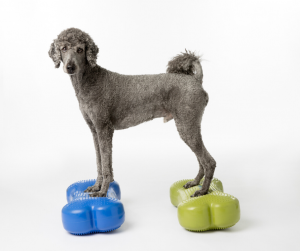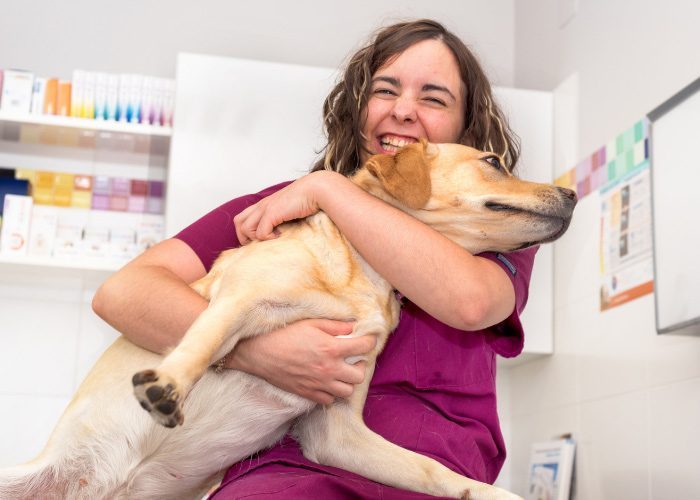 A guest article by
A guest article by
Ané Lloyd, Veterinary Physiotherapist
Content Coordinator with Onlinepethealth
How arthritis can affect your dog
Arthritis affects dogs in the same way it does people, leading to chronic pain, reduced range of motion or mobility of joints, loss of muscle strength or muscle atrophy, weight gain, and an overall reduction in quality of life. Arthritis is a degenerative condition; it cannot be cured, but it can certainly be managed. With the right care, each of the symptoms can be treated to slow down the process of degeneration and reduce the overall effect on your dog’s quality of life.
Dogs get arthritis for various reasons. The first is simply aging – joints get old and worn, causing inflammation. But arthritis is not only an old dog’s disease. Any joint will develop arthritis if subject to constant abnormal forces – such as when a dog is overweight, or when a dog is mechanically compromised. The three-legged dog, for example, will constantly place extra weight on the remaining legs and change the way he uses and moves those limbs, which will lead to arthritis in one or more of the joints in the remaining limbs.
A joint will also develop arthritis if the joint surface is damaged in any way, as will happen if a joint is injured, if a surgery is performed, or if the dog has a condition like hip dysplasia or elbow dysplasia. Joints can be damaged when a dog continually performs a high impact activity, such as jumping over a high fence, or in and out of your vehicle several times a day, every day – or performing such activities from a very young age. Stairs can be a culprit here too – young, heavy-breed dogs traveling up and down flights of stairs from a very young age are prone to develop arthritis in their elbows.
Arthritis can be debilitating, severely shortening a dog’s lifespan and negatively impacting on the time they have with you. Your arthritic dog loses his ability to get up or down on his own, can no longer climb stairs, becomes increasingly inactive and rather grumpy, and is in continuous pain. All of this is unpleasant for both dog and owner.
Arthritis does not have to be so debilitating. Much can be done to help you, the owner, manage the condition, slow its progress, and reduce the severity of the symptoms. The first thing you’ll want to do is arm yourself with a healthcare team who will walk the road with you and your dog, helping to keep your pet healthy, happy, and pain-free. There is no need for your dog to suffer through this slow, ruinous condition; nowadays, using a variety of modalities and fields of knowledge, a competent team can greatly alleviate arthritis-related suffering and prolong an excellent quality of life.
Your healthcare team
Your healthcare team should comprise at least your vet and your canine physical therapist (PT) and can include additional professionals such as a hydrotherapist, vet technician, and nutritionist. A good vet and PT are the crucial members. Your vet and PT will work together to make sure that the best, most comprehensive treatment plan is developed for your dog.
Your vet will monitor the severity and the progression of your dog’s arthritis, prescribe pain medication as and when needed, and advise you on any surgical options that may be available at different points during the progression of the disease.
Your veterinary PT will play a different, equally essential role. Below are some of the reasons why a PT is so important for the management of a condition like arthritis:
Your PT forms a relationship with you and your dog
This may sound trivial, but it may be the most valuable thing your physio does for you.
Your PT will advise you, encourage you, support you, and assist you in ways you and your individual dog need most as the disease progresses.
Your PT will equip you with the tools to understand and take control of the condition, empowering you to manage your dog in a home program for long stretches between visits to the vet and PT.
Your PT will help you become sensitive to the signs of pain your dog gives you, teach you to recognize a period of degeneration, and advise on what to do when it comes.
Reduce pain
Through a variety of modalities – including massage, mobilization, targeted therapeutic exercise and more – your PT will reduce your dog’s pain and keep him off pain medication for as long as possible. Pain medication can take a toll on a dog’s organs, leading to organ failure when used over an extended time. We want to prevent or reduce the side effects of pain medication for as long as possible, using pain medication for short stretches when needed, and only increasing usage when all other avenues are no longer effective.
Improve mobility
 Your PT will improve the mobility of the joints affected by arthritis, firstly by getting the pain under control, and then by slowly improving both the joint’s ability to move through the use of joint mobilizations and your dog’s overall ability to move the joints during targeted exercises.
Your PT will improve the mobility of the joints affected by arthritis, firstly by getting the pain under control, and then by slowly improving both the joint’s ability to move through the use of joint mobilizations and your dog’s overall ability to move the joints during targeted exercises.
Targeted exercises have two key effects; your dog will experience better mobility and therefore function, and the overall health of the joint will improve.
Improve strength
Joints need to move to stay healthy, but must be moved in the right way, and only after pain has been dealt with. Moving in an untargeted way while the dog is still in pain will have the opposite effect than the one intended, it will entrench incorrect, compensatory patterns of movement that do nothing to strengthen the muscles that need strengthening.
Your PT will help to strengthen the muscles and ligaments that surround the affected joints. This will help stabilize the joints and improve the way in which your dog moves not only the joint and limb but his whole body – which means less pain and dysfunction due to compensation.
Improve endurance
As your dog’s pain, movement and strength improve, so will his endurance. You may well find your grumpy, ‘old’ dog returns to being the playful, energetic youngster he used to be! The better your dog’s muscle strength and endurance, the better he will cope with the activities of daily life in a functional, pain-free way.
Weight control
For some dogs, weight is a huge challenge, with many compounding factors causing weight gain. Your PT will help you to monitor your dog’s weight, advise you on the changes you need to make, and devise ways to keep that weight at the best possible level for your dog. This alone will have a major impact on slowing down the progression of their arthritis and reducing your dog’s pain.
Quality of life
By now you will have gathered that everything a PT does leads to a vastly improved quality of life for the arthritic dog. A dog that has been well managed by a competent PT will once again be able to participate in family activities, play, enjoy food, and be the happy, healthy dog you long to see.
It is hard to notice your dog slowing down and losing his zest for life, something you may have attributed to old age. The reality is we can stave off these symptoms for years. Once you start treating their arthritis with the help of a competent team, you may well be astounded at the changes you see!
Remember: It might seem like a lot, but it’s possible to successfully manage arthritis!
Managing arthritis proactively adds years to your dog’s life and life to his years. Your PT can deliver all of the above benefits to you and your dog, and completely change your mind about how you view arthritis. It is not a death sentence; it is an opportunity for a commitment that could change you and your dog’s lives for the better.
I have given a few good reasons why your arthritic dog should see a Canine Physical Therapist, but there are many more. In brief – arthritis is often accompanied by other conditions, and the medication used to help manage these conditions can have many side effects. Your PT will help you monitor, treat, and manage these side effects together with your veterinarian.
If you’re feeling overwhelmed right now, just know you are not alone. We love our dogs and cannot bear to see them suffer. If you need help finding a veterinary rehabilitation professional, you can find some here.
NOTE: For people in the United States, please note that human physical therapists need additional training to work with animals. Find a Veterinary Rehab Professional near you
This blog post originally appeared on Onlinepethealth

